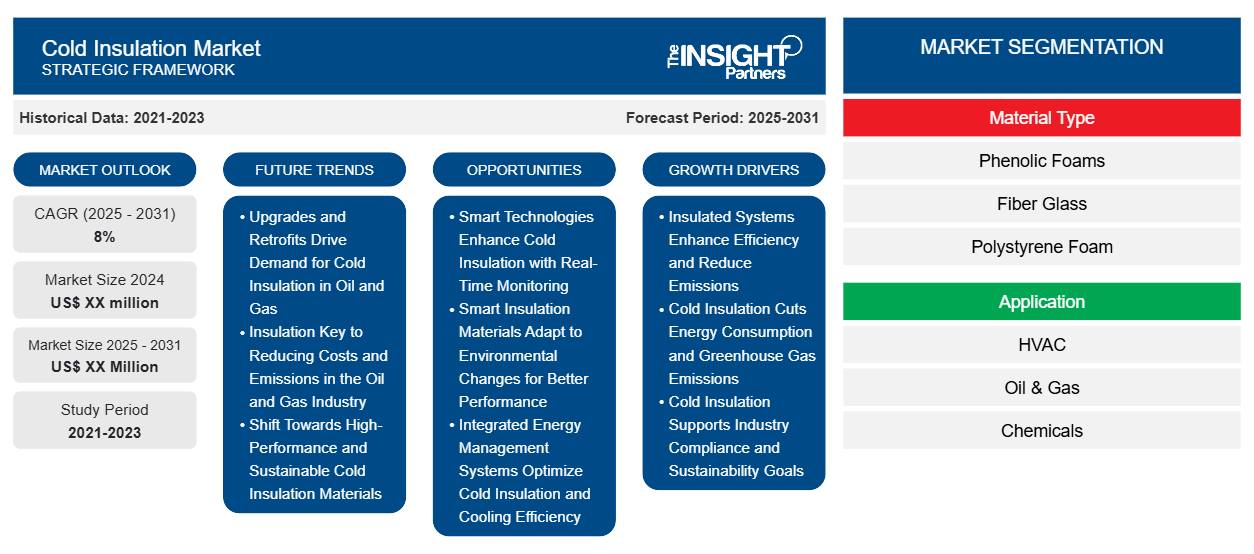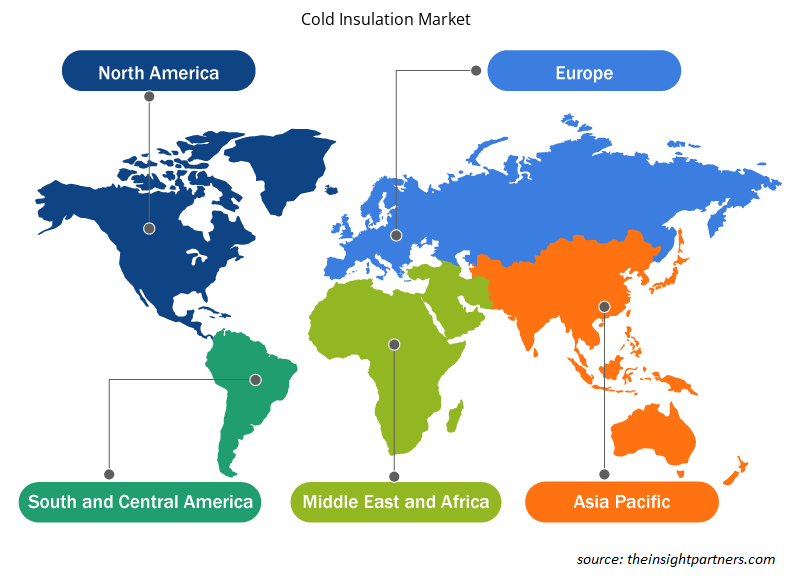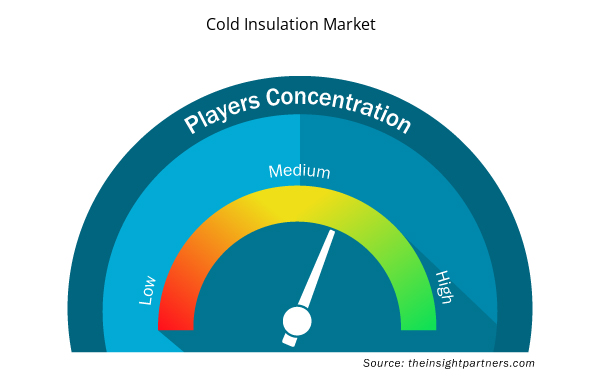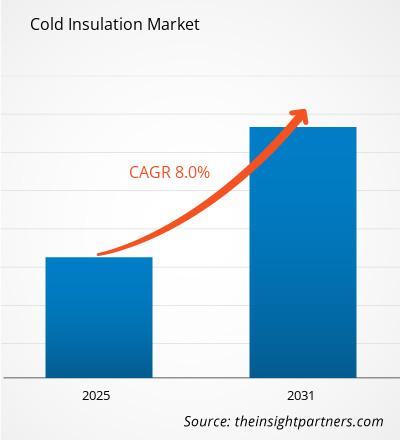The Cold Insulation Market Size and Forecasts (2021 - 2031), Global and Regional Share, Trends, and Growth Opportunity Analysis Report Coverage:by Material Type (Phenolic Foams, Fiber Glass, Polystyrene Foam, Polyurethane Foam, and Others) and Application (HVAC, Oil & Gas, Chemicals, Refrigeration,and Others), and Geography (North America, Europe, Asia Pacific, and South and Central America) is expected to register a CAGR of 8% from 2025 to 2031, with a market size expanding from US$ XX million in 2024 to US$ XX Million by 2031.
The report is segmented by Material Type (Phenolic Foams, Fiber Glass, Polystyrene Foam, Polyurethane Foam, and Others) and Application (HVAC, Oil & Gas, Chemicals, Refrigeration,and Others), and Geography (North America, Europe, Asia Pacific, and South and Central America). The global analysis is further broken-down at regional level and major countries.
Cold insulation consists of materials and systems that prevent heat transfer when there are low temperatures to be retained during refrigeration, cryogenics, and other processes. It is mostly applied to restrict or to minimize the amount of heat that must be gained by the surrounding environment to keep the low temperature of the materials or fluids being insulated.
Purpose of the Report
The report Cold Insulation Market Size and Forecasts (2021 - 2031), Global and Regional Share, Trends, and Growth Opportunity Analysis Report Coverage:by Material Type (Phenolic Foams, Fiber Glass, Polystyrene Foam, Polyurethane Foam, and Others) and Application (HVAC, Oil & Gas, Chemicals, Refrigeration,and Others), and Geography (North America, Europe, Asia Pacific, and South and Central America) by The Insight Partners aims to describe the present landscape and future growth, top driving factors, challenges, and opportunities. This will provide insights to various business stakeholders, such as:
- Technology Providers/Manufacturers: To understand the evolving market dynamics and know the potential growth opportunities, enabling them to make informed strategic decisions.
- Investors: To conduct a comprehensive trend analysis regarding the market growth rate, market financial projections, and opportunities that exist across the value chain.
- Regulatory bodies: To regulate policies and police activities in the market with the aim of minimizing abuse, preserving investor trust and confidence, and upholding the integrity and stability of the market.
Cold Insulation Market Size and Forecasts (2021 - 2031), Global and Regional Share, Trends, and Growth Opportunity Analysis Report Coverage:by Material Type (Phenolic Foams, Fiber Glass, Polystyrene Foam, Polyurethane Foam, and Others) and Application (HVAC, Oil & Gas, Chemicals, Refrigeration,and Others), and Geography (North America, Europe, Asia Pacific, and South and Central America) Segmentation
Material Type
- Phenolic Foams
- Fiber Glass
- Polystyrene Foam
- Polyurethane Foam
- Others
Application
- HVAC
- Oil & Gas
- Chemicals
- Refrigeration
- Others
Customize This Report To Suit Your Requirement
You will get customization on any report - free of charge - including parts of this report, or country-level analysis, Excel Data pack, as well as avail great offers and discounts for start-ups & universities
Cold Insulation Market: Strategic Insights

- Get Top Key Market Trends of this report.This FREE sample will include data analysis, ranging from market trends to estimates and forecasts.
Cold Insulation Market Size and Forecasts (2021 - 2031), Global and Regional Share, Trends, and Growth Opportunity Analysis Report Coverage:by Material Type (Phenolic Foams, Fiber Glass, Polystyrene Foam, Polyurethane Foam, and Others) and Application (HVAC, Oil & Gas, Chemicals, Refrigeration,and Others), and Geography (North America, Europe, Asia Pacific, and South and Central America) Growth Drivers
- Insulated Systems Enhance Efficiency and Reduce Emissions: Insulated systems operate at higher efficiencies, meaning less emission due to additional cooling or heating. The equipment lasts longer with the reduced maintenance requirements, and this again lowers emissions from manufacturing and transport.
- Cold Insulation Cuts Energy Consumption and Greenhouse Gas Emissions: Cold insulation reduces the energy consumption when keeping a low temperature by minimizing heat transfer. Thus, it reduces the consumption of electricity, which will, to an extent, minimize the release of greenhouse gases associated with energy production directly.
- Cold Insulation Supports Industry Compliance and Sustainability Goals: In industrial applications, the optimum insulation guarantees that maximum temperatures within the process are achieved and, thus, diminishes all energy used to heat or cool it can reduce carbon footprint. Most producers are under pressure from regulation to reduce emissions. The use of cold insulation will help industries meet the standards in place without the charge for failing to do so while maximally enhancing sustainability.
Cold Insulation Market Size and Forecasts (2021 - 2031), Global and Regional Share, Trends, and Growth Opportunity Analysis Report Coverage:by Material Type (Phenolic Foams, Fiber Glass, Polystyrene Foam, Polyurethane Foam, and Others) and Application (HVAC, Oil & Gas, Chemicals, Refrigeration,and Others), and Geography (North America, Europe, Asia Pacific, and South and Central America) Future Trends
- Upgrades and Retrofits Drive Demand for Cold Insulation in Oil and Gas: Oil and gas manufacturers upgrades or retrofit older pipelines and facilities to improve efficiency, leading to greater demand for effective cold insulation solutions. Aging systems may need more frequent maintenance, prompting the use of insulation to enhance energy efficiency and prevent heat loss.
- Insulation Key to Reducing Costs and Emissions in the Oil and Gas Industry: Companies are shifting to reduce operation cost and emissions and hence insulation is critical to the optimize of energy utilization in both cooling and storage. The industry is being squeezed by increasingly tight environmental regulations, pushing it towards adoption of new technologies in the quest for energy efficiency and reduced emissions-for instance, higher efficiency in insulating materials.
- Shift Towards High-Performance and Sustainable Cold Insulation Materials: The demand for high performance materials is the major trend driving the cold insulation materials market. The shift toward more sustainable practices may encourage the adoption of insulation materials that have lower environmental impacts throughout their lifecycle.
Cold Insulation Market Size and Forecasts (2021 - 2031), Global and Regional Share, Trends, and Growth Opportunity Analysis Report Coverage:by Material Type (Phenolic Foams, Fiber Glass, Polystyrene Foam, Polyurethane Foam, and Others) and Application (HVAC, Oil & Gas, Chemicals, Refrigeration,and Others), and Geography (North America, Europe, Asia Pacific, and South and Central America) Opportunities
- Smart Technologies Enhance Cold Insulation with Real-Time Monitoring: Smart technologies are likely to revolutionize the cold insulation industry through efficiency, monitoring, and sustainability. Smart sensors and IoT devices are used to monitor the performance in real time. Parameters like temperature, humidity, and thermal conductivity are analyzed to determine insulation performance. Such deviations in performance might even stem from increased heat transfer, and operators could intervene forthwith to correct such causes, thus making sure optimal working conditions as well as a reduction in energy waste.
- Smart Insulation Materials Adapt to Environmental Changes for Better Performance: Smart insulation materials react to environmental conditions due to advances in material science. For example, phase change materials may absorb and release heat as required to maintain stable temperatures. Such materials are so versatile that they can even enhance the performance of cold insulation systems by accommodating shifting operating conditions.
- Integrated Energy Management Systems Optimize Cold Insulation and Cooling Efficiency: Integrated energy management systems can optimize the entire refrigeration or cryogenic process by coordinating the operation of insulations with cooling equipment. Their analysis of patterns allows identification of inefficiencies and suggestions for adjustment, leading to tremendous savings in energy while reducing the operational costs.
Cold Insulation Market Regional Insights
The regional trends and factors influencing the Cold Insulation Market throughout the forecast period have been thoroughly explained by the analysts at Insight Partners. This section also discusses Cold Insulation Market segments and geography across North America, Europe, Asia Pacific, Middle East and Africa, and South and Central America.

- Get the Regional Specific Data for Cold Insulation Market
Cold Insulation Market Report Scope
| Report Attribute | Details |
|---|---|
| Market size in 2024 | US$ XX million |
| Market Size by 2031 | US$ XX Million |
| Global CAGR (2025 - 2031) | 8% |
| Historical Data | 2021-2023 |
| Forecast period | 2025-2031 |
| Segments Covered |
By Material Type
|
| Regions and Countries Covered | North America
|
| Market leaders and key company profiles |
Cold Insulation Market Players Density: Understanding Its Impact on Business Dynamics
The Cold Insulation Market market is growing rapidly, driven by increasing end-user demand due to factors such as evolving consumer preferences, technological advancements, and greater awareness of the product's benefits. As demand rises, businesses are expanding their offerings, innovating to meet consumer needs, and capitalizing on emerging trends, which further fuels market growth.
Market players density refers to the distribution of firms or companies operating within a particular market or industry. It indicates how many competitors (market players) are present in a given market space relative to its size or total market value.
Major Companies operating in the Cold Insulation Market are:
- Huntsman Corporation
- BASF SE
- The Dow Chemical Company
- Owens Corning
- Bradford Insulation Industries Ltd
Disclaimer: The companies listed above are not ranked in any particular order.

- Get the Cold Insulation Market top key players overview
Key Selling Points
- Comprehensive Coverage: The report comprehensively covers the analysis of products, services, types, and end users of the Cold Insulation Market Size and Forecasts (2021 - 2031), Global and Regional Share, Trends, and Growth Opportunity Analysis Report Coverage:by Material Type (Phenolic Foams, Fiber Glass, Polystyrene Foam, Polyurethane Foam, and Others) and Application (HVAC, Oil & Gas, Chemicals, Refrigeration,and Others), and Geography (North America, Europe, Asia Pacific, and South and Central America), providing a holistic landscape.
- Expert Analysis: The report is compiled based on the in-depth understanding of industry experts and analysts.
- Up-to-date Information: The report assures business relevance due to its coverage of recent information and data trends.
- Customization Options: This report can be customized to cater to specific client requirements and suit the business strategies aptly.
The research report on the Cold Insulation Market Size and Forecasts (2021 - 2031), Global and Regional Share, Trends, and Growth Opportunity Analysis Report Coverage:by Material Type (Phenolic Foams, Fiber Glass, Polystyrene Foam, Polyurethane Foam, and Others) and Application (HVAC, Oil & Gas, Chemicals, Refrigeration,and Others), and Geography (North America, Europe, Asia Pacific, and South and Central America) can, therefore, help spearhead the trail of decoding and understanding the industry scenario and growth prospects. Although there can be a few valid concerns, the overall benefits of this report tend to outweigh the disadvantages.
- Historical Analysis (2 Years), Base Year, Forecast (7 Years) with CAGR
- PEST and SWOT Analysis
- Market Size Value / Volume - Global, Regional, Country
- Industry and Competitive Landscape
- Excel Dataset



Report Coverage
Revenue forecast, Company Analysis, Industry landscape, Growth factors, and Trends

Segment Covered
This text is related
to segments covered.

Regional Scope
North America, Europe, Asia Pacific, Middle East & Africa, South & Central America

Country Scope
This text is related
to country scope.
Frequently Asked Questions
Adopting smart technologies like machine learning algorithm, smart sensors, IoT devices are some upcoming trends in cold insulation market
Saint-Gobain, Knauf Insulation,BASF SE, Huntsman Corporation, Synthos SA, Celanese Corporation, Rockwool, Armacell and Kingspan Group are among major players leading the cold insulation market.
Based on geography, Western regions like Europe and North America together held the largest share in cold insulation market.
Asia Pacific is anticipated to grow at a faster pace then other regions in cold insulation market.
The rising demand for insulation and focus on improving efficiency especially in oil and gas and HVAC industries.
The Cold Insulation Market Size and Forecasts (2021 - 2031), Global and Regional Share, Trends, and Growth Opportunity Analysis Report Coverage:by Material Type (Phenolic Foams, Fiber Glass, Polystyrene Foam, Polyurethane Foam, and Others) and Application (HVAC, Oil & Gas, Chemicals, Refrigeration,and Others), and Geography (North America, Europe, Asia Pacific, and South and Central America) is estimated to witness a CAGR of 8% from 2023 to 2031
Trends and growth analysis reports related to Chemicals and Materials : READ MORE..
1. Huntsman Corporation
2. BASF SE
3. The Dow Chemical Company
4. Owens Corning
5. Bradford Insulation Industries Ltd
6. Dongsung Finetec Corporation
7. Bayer Materialscience
8. Pittsburgh Corning Corporation
9. Aspen Aerogel Inc.
10. Armacell International Holding GmbH

 Get Free Sample For
Get Free Sample For